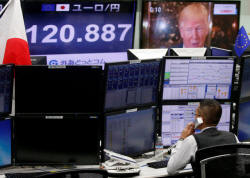|
Trump's protectionist
policies top risk to U.S. economy in 2017: Reuters poll
 Send a link to a friend
Send a link to a friend
 [January 18, 2017]
By Anu Bararia and Sumanta Dey [January 18, 2017]
By Anu Bararia and Sumanta Dey
(Reuters) -
The
top risk to U.S. growth would come if U.S. President-elect Donald Trump
keeps his protectionist promises, according to a Reuters poll that shows
economists have not joined in the market exuberance since the shock
November vote.
For most of his campaign and after the election, Trump vowed to make
sweeping changes to U.S. trade and immigration policy, threatened to
impose steep tariffs on Chinese imports and proposed hefty tax cuts.
While financial markets have retreated in the past week and hopes of a
sudden spurt in inflation have faded, U.S. 10-year Treasury yields are
still up more than 25 percent since Election Day, and stocks have hit
record highs.
Still, more than two-thirds of the 70 respondents to the question in the
Reuters survey taken over the past week said Trump's protectionist
policies were the biggest threat to the world's largest economy this
year.
"There is no question that near the top of the list of downside risks is
the potential for more follow-through on the anti-free trade rhetoric,"
said Jim O'Sullivan of High Frequency Economics.
"I am kind of assuming that the (incoming) administration will be
practical on this," said O'Sullivan, the top forecaster of U.S. economic
data in Reuters polls for 2016, the second year in a row he achieved
that distinction.
The strong dollar, which hit a 14-year high early this month and is up
close to 6 percent since Trump was elected, poses an additional
near-term risk.

Worries around the globe over Trump's confrontational style and a
strengthening dollar are likely to be key themes among political and
business leaders at the World Economic Forum in Davos, Switzerland, this
week.
Sweeping tax cuts for businesses and individuals, and the prospect of
some infrastructure spending, have also not brightened prospects for
U.S. economic growth, which Trump has said he aimed to boost to 3.5
percent.
More than 80 percent of respondents said "no" when asked if now was the
right time for such aggressive tax cuts, with the economy close to full
employment. The unemployment rate was 4.7 percent in December.
TOO OPTIMISTIC
The latest poll estimated growth slowed to 2.2 percent in the fourth
quarter from 3.5 percent in the third quarter.
Through 2017, economists predicted the economy would expand at an annual
rate of 2.1 percent to 2.5 percent each quarter, just 0.1 percentage
point higher than the previous estimate. The full-year median was 2.3
percent.
The most optimistic growth forecast for any point in 2017 was 4.1
percent, far short of the post-financial crisis peak of 5.6 percent hit
in the fourth quarter of 2009.
[to top of second column] |

An employee of a foreign exchange trading company works near
monitors showing U.S. President-elect Donald Trump (top R), and the
Japanese yen's exchange rate against the euro in Tokyo, Japan,
January 18, 2017. REUTERS/Toru Hanai

"Obviously people have been assuming the growth-sapping parts
(protectionist measures) are not followed through, but they may have run
ahead of themselves in predicting how much stimulus will be enacted and
how much growth will be boosted," said O'Sullivan, who was also the most
optimistic on growth among the top forecasters.
A little fewer than one-third of the respondents, including three of the
top 10 U.S. economy forecasters in Reuters polls last year, upgraded
their 2017 growth outlooks in the latest poll.
Many of them, like O'Sullivan, said it was mainly on the assumption
Trump would not follow through on his restrictive trade agenda and
instead focus on boosting growth through fiscal measures.
While those projected growth rates may be considered healthy for the
economy at such a late stage of the recovery cycle, they could do little
to boost inflation much beyond the Federal Reserve's 2 percent target.
Inflation pressure is more likely to come from a round of retaliatory
tariffs if Trump's protectionist agenda becomes a global reality.
Even though pay growth is forecast to average 3.0 percent this year, up
from 2.8 percent in December's poll, the Fed's preferred gauge of
inflation, the Core PCE Price Index, will probably average 1.8 percent
in 2017 and 2.0 percent in 2018, unchanged from the last poll.
Fed policymakers recently warned that with the economy close to full
employment, an expansive fiscal policy could lead to faster rate hikes
than currently priced in, pushing the U.S. dollar higher.
"If the unemployment rate falls some more, it is going to add to upward
pressure on wages and inflation and reinforce the case for Fed
tightening," O'Sullivan said.
The wider poll of over 100 economists, including 17 large banks that
transact directly with the Fed, showed rates would remain unchanged at
0.50 percent to 0.75 percent until the second quarter, when a
25-basis-point hike is likely.
A follow-up increase is expected in the fourth quarter, taking the Fed
funds rate to a range of 1.00 percent to 1.25 percent. Fourteen
economists, however, forecast a hike by March.
(For other stories from the poll)
(Polling and analysis by Sarmista Sen and Purnita Deb; Editing by Ross
Finley and Lisa Von Ahn)
[© 2017 Thomson Reuters. All rights
reserved.] Copyright 2017 Reuters. All rights reserved. This material may not be published,
broadcast, rewritten or redistributed.
 |